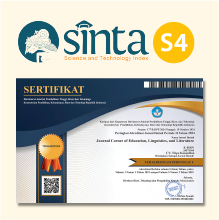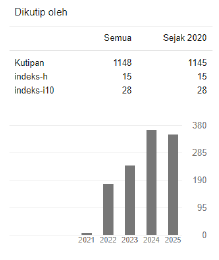Children Empowerment in C.S. Lewis’ novel “The Lion, the Witch and the Wardrobe”
 https://doi.org/10.54012/jcell.v1i4.42
https://doi.org/10.54012/jcell.v1i4.42
 Abstract views: 1281
Abstract views: 1281
 PDF downloads: 543
PDF downloads: 543
Keywords:
Character building, children empowerment, children literature, Lucy’s thoughts, feelings, and ActionsAbstract
This research is aimed to describe Lucy’s thoughts, feelings, and actions in C.S. Lewis’s novel The Lion, the Witch, and the Wardrobe. The problem formulated in the research will be answered based on Lucy’s thoughts, actions, and feelings and then describe it. The main source for this research was C.S. Lewis’s novel The Lion, the Witch, and the Wardrobe. This novel is considered children’s literature. The focus and the data for this research were events in the novel which showed Lucy’s thoughts, feelings, and actions. The data were analyzed by using qualitative content analysis. The instrument was the researcher himself. There are four criteria: credibility, transferability, dependability, and confirmability, which the researcher used in order to make trustworthiness. The findings revealed that Lucy reflected her thoughts through knowledge and ideas, and understanding others’ feelings; her feelings through empathy and unselfishness; and her actions through her bravery and doing a favor for others. Therefore, this novel contains children’s empowerment, which can be categorized as a good novel. Furthermore, children's empowerment is considered an important aspect in children’s stories and it has a great influence to enrich children’s intelligence and emotion in their growing period.
Downloads
References
Dalman, Hesti, & Apriyanto, S. (2020). Conversational implicature: A pragmatic study of “our conversation” in learning at university. International Journal of Psychosocial Rehabilitation, 24(8), 4332–4340. https://doi.org/10.37200/IJPR/V24I8/PR280450
Elo, S., Kääriäinen, M., Kanste, O., Pölkki, T., Utriainen, K., & Kyngäs, H. (2014). Qualitative content analysis: A focus on trustworthiness. Sage Open. 1-10.
Erdoğan, R. (2017). Eflâtun Cem Güney’ in masallarındaki değerler ve bu değerlerin davranışa yansıma biçimleri [Values in the tales of Eflâtun Cem Güney and their forms of reflection to behaviour] (Yayınlanmamış yüksek lisans tezi). Atatürk Üniversitesi, Erzurum.
Fidan, M. (2019). Fantastik metinlerin değerler eğitiminde kullanılabilirliği üzerine değerlendirme-hikmet temel akarsu örneği [Evaluation of usability of fantastic texts in values education - The sample of Hikmet Temel Akarsu]. Kırıkkale Üniversitesi Sosyal Bilimler Dergisi, 9(1), 127-138.
Fidan, N. K., & Ulu, H. (2021). An analysis of the studies on “The values in children’s literature products” in Turkey. International Journal of Contemporary Educational Research, 8(3), 103-118. https://doi.org/10.33200/ijcer.881495.
Kaçmaz, G. (2018). Cahit Zarifoğlu'nun masallarının değerler eğitimi ve sözvarlığı açısından incelenmesi [Values education and vocabulary in Cahit Zarifoğlu’s children’s literature Works] (Yayınlanmamış yüksek lisans tezi). İnönü Üniversitesi, Malatya.
Karagöz, B. (2017). Naki Tezel‟in Türk masalları adlı kitabının değerler açısından analizi [Analysis of Naki Tezel‟s book Turkish tales in terms of values]. Ana Dili Eğitimi Dergisi, 5(3), 534-556.
Kılıç, A., & Aktan, O. (2015). İlköğretim okulları için tavsiye edilen 100 temel eserde vurgulanan değerler [Values emphasized in the list of recommended books for primary schools as 100 primary Works]. İlköğretim Online, 14(1), 243-275.
Koss, M. D. (2015). Diversity in contemporary picturebooks: A content analysis. Journal of Children’s Literature, 41(1), 32-42
Kusuma, H. A., & Apriyanto, S. (2018). Strategy on Developing English Learning Material for Specific Purposes. IJECA (International Journal of Education and Curriculum Application), 1(3), 39. https://doi.org/10.31764/ijeca.v1i3.2144
Lewis, C. S. (1950). The lion, the witch, and the wardrobe. United Kingdom: Geoffrey Bles.
Lynch-Brown, C., & Tomlinson, C. M. (1999). Essentials of children’s literature. Needham Heights, USA: Allyn & Bacon.
McAdam, J. E., Ghaida, S. A., Arizpe, E., Hirsu, L., & Motawy, Y. (2020). Children’s literature in critical contexts of displacement: exploring the value of hope. Education Science, 10(383), 1-13.
Muchtar, A. D., & Suryani, A. (2019). Pendidikan karakter menurut Kemendikbud (telaah pemikiran atas Kemendikbud). Edumaspul: Jurnal Pendidikan, 3(2), 50-57.
Reynolds, K. (2011). Children’s literature: A very short introduction. New York, NY: Oxford University Press Inc.
Subyantoro, S., & Apriyanto, S. (2020). Impoliteness in Indonesian Language Hate Speech on Social Media Contained in the Instagram Account. Journal of Advances in Linguistics, 11, 36–46. https://doi.org/10.24297/jal.v11i.8655
Tümen, T. (2018). Naki Tezel’in masalları ve değerler eğitimi açısından incelenmesi [Analysis of Naki Tezel’s book Turkish Tales in terms of values] (Yayınlanmamış yüksek lisans tezi). İnönü Üniversitesi, Malatya.
Tyra, C. (2012). Bringing books to life: Teaching character education through children’s literature. Rising Tide, 5, 1-16.
Yoo-Lee, E., Fowler, L., Adkins, D., Kim, K., & Davis, H. N. (2014). Evaluating cultural authenticity in multicultural picture books: A collaborative analysis for diversity education. Library Quarterly: Information, Community, Policy, 84(3), 324–347.
Downloads
Published
How to Cite
Issue
Section
License
Copyright (c) 2022 Adi Irma Suryadi, Dariyana

This work is licensed under a Creative Commons Attribution-ShareAlike 4.0 International License.
All articles published in the Journal Corner of Education, Linguistics, and Literature are licensed under the Creative Commons Attribution-ShareAlike License (CC BY-SA).

















